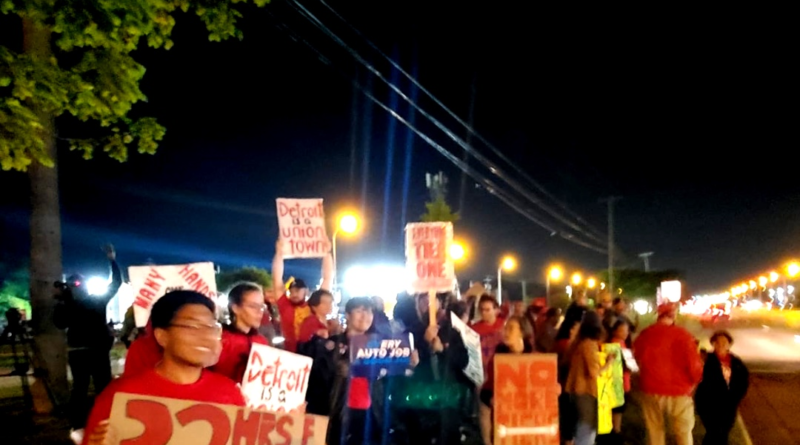What the continued UAW strike means for EVs
The United Auto Workers’ strike against General Motors, Ford and Stellantis is well into its fourth day, with no deal in sight. The strike comes as all three automakers have made aggressive moves to retool existing factories to build electric vehicles. Delays could set back production and delivery of current and future EV models, while also raising prices for consumers.
Nearly 13,000 workers began picketing Friday at midnight after a deal wasn’t reached by the UAW’s deadline. UAW president Shawn Fain on Monday evening set a new deadline for September 22.
The UAW isn’t striking all of its 150,000 members at once. In a tactic Fain is calling a “stand up strike,” the union is targeting specific factories at a time. The first were GM’s truck and van plant in Wentzville, Missouri; Ford’s Ranger pickup and Bronco SUV plant in Wayne, Michigan; and Stellantis’ Jeep Wrangler and Gladiator plant in Toledo, Ohio.
On Monday, Unifor, the union that represents autoworkers in Canada, also said it would strike against Ford at midnight if a deal isn’t reached. The strike in Canada could affect Ford operations at some of its U.S. plants.
At the center of the fight is the shift to electric vehicles. EVs require fewer parts, and thus fewer workers to assemble vehicles, so union members are fighting to secure their livelihoods in addition to better working conditions. Traditional OEMs are pumping money into electrifying their production lines and are anxious to keep costs down so they don’t lose market share to Tesla. Tesla is already producing EVs profitably via its non-unionized workforce.
“Let’s be clear: this is a potential nightmare situation for GM and Ford as both 313 stalwarts are in the early stages of a massive EV transformation path for the next decade that will define future success,” wrote Dan Ives, an analyst at Wedbush Securities. “In this crucial period of EV execution, model roll-outs, distribution, marketing, with EV competition rising across the board, the timing could not be worse.”
Production delays, rising cost of EVs
Analysts say a lengthy strike would delay production and rollout of new electric vehicles. One the lasts more than four weeks would see production timelines and EV roadmaps pushed out to 2024, with many more delays on the horizon for GM, Ford and Stellantis, according to Ives. This, of course, would be a boon for Tesla in the near term as consumer demand for EVs continues.
Ford, Stellantis and GM are already struggling to get their EVs to market. Ford in February was forced to suspend production of its electric F-150 Lightning pickup after a battery caught fire in one of the vehicles parked near the factory for a quality check. The company also previously reported a 2.8% drop in EV sales in the second quarter after pausing production at the Mexico factory that assembles the Mustang Mach e. Stellantis doesn’t intend to begin selling fully electric vehicles in the U.S. until 2025. And GM’s new battery factory in Ohio has been slow to produce batteries, which has delayed electric versions of the Chevrolet Silverado and other vehicles.
The UAW’s key demands are a 36% hourly pay increase, a reduced 32-hour work week, a shift back to traditional pensions, the elimination of compensation tiers and the restoration of cost-of-living adjustments.
If, after negotiations, some of the UAW’s major proposals are granted, it would end up costing the OEMs billions of dollars in incremental annual costs. Ives said these costs will ultimately fall on the end consumer as it would cause the increase of EV prices rolling out over the next 12 to 18 months.
Some analysts don’t buy the idea that meeting union demands would put the three automakers in such dire straights.
“If you look at the breakdown at what it costs to build an E.V., labor is a very small part of the equation. Batteries are the most,” Madeline Janis, executive director of advocacy group Jobs to Move America, told The New York Times. “This idea that the UAW is going to price Ford, G.M. and Stellantis out of the market is not true.”
Ford, GM threaten to scrap EV transition
“Union demands would force Ford to scrap its investments in electric vehicles,” said Jim Farley, Ford’s CEO. “We want to actually have a conversation about a sustainable future. Not one that forces us to choose between going out of business and rewarding our workers.”
Ford said that if the union got everything it wants, its workers’ total compensation would be twice as much as Tesla’s employees. It would also be higher than the labor costs of Toyota and other foreign-owned automakers in the U.S. that use non-union labor.
“First off, labor costs are about 5% of the cost of the vehicle. They could double our wages and not raise the price of the vehicles and still make billions in profits. It’s a choice,” countered Fain in a CBS interview over the weekend. “And the fact that they want to compare it to how pitiful Tesla pays their workers and other companies pay their workers. That’s what this whole argument’s about. Workers in this country got to decide if they want a better life for themselves, instead of scraping to get by paycheck to paycheck, while everybody else walks away with the loot.”
Ford reported in July that its EV business would lose $4.5 billion this year. But even with that projected loss, Ford raised its full-year guidance for 2023 to between $11 billion and $12 billion in adjusted earnings, up from between $9 billion and $11 billion.
The automaker told TechCrunch that the UAW’s demands “would wipe out billions of dollars of profitability that is essential to investing in our future.”
Speaking to CBS Mornings late last week, GM’s CEO Mary Barra said an excessive pay rise would hinder the automaker’s ability to continue producing vehicles with combustion engines while also developing EVs.
“This is a critical juncture where investing is very important,” she said.
CEO-to-worker pay gap in the spotlight
Unions aren’t likely to be swayed by auto executives’ arguments against giving workers radical pay rises. It’s the large pay gaps between those very executives and their workers that are rallying union members to the cause.
“We’ve asked for 40% pay increases and the reason we asked for 40% pay increases is because in the last four years alone, the CEO pay went up 40%. They’re already millionaires,” said Fain during an interview with CBS.
Barra’s $29 million pay package in 2022 was about 362x the median GM employee’s salary. Farley received nearly $21 million in total compensation in 2022, which is about 281x Ford’s average employee wage. And Stellantis CEO Carlos Tavares made 23.46 million euros in 2022, which is around 365x the average employee wage.
Ford has countered the notion that its CEO has received a 40% pay bump in the last four years. Farley became CEO of Ford in 2020. Farley’s salary is up 21% from his predecessor Jim Hackett’s salary in 2019. Ford did not clarify how many points Farley’s salary increased from 2020 to 2023.
Shareholders of all three companies have also been rewarded with dividends and share buybacks.
According to the Economic Policy Institute, adjusted for inflation, wages for autoworkers in the U.S. have fallen 19% since 2008.
The UAW has since decreased its wage increase demand to a 36% pay rise. Stellantis recently offered a 21% increase over four years, and Ford and GM have offered 20% pay bumps. The union rejected all three proposals.
Workers want a say in EV future
“Our tax dollars are financing a massive portion of this transition to EV,” said Fain on CBS. “But this transition has to be a just transition and a just transition means, if our tax dollars are going to finance this transition, then labor can’t be left behind. And as it stands right now, the workers are being left behind. The companies want to talk about being competitive. It’s not about being competitive. Competitive is the code word for race to the bottom. What they want is they want to pay us poverty wages, so they can keep on making billions more in profits. And they can keep enriching the shareholders and the CEOs and the corporate executives, while the workers pay the price for it and get left behind. That’s got to stop in this country.”
Automakers have made record profits in the last decade, but they can’t afford to fall behind in their race to compete with Tesla and foreign autoworkers.
Tesla has the upper hand today with its non-unionized workforce, but there’s a chance that the UAW’s momentum could be contagious. The UAW has not responded to TechCrunch’s inquiries about whether it is approaching workers at Tesla and other carmakers like Hyundai, which plans to build EVs at a massive new factory in Georgia. The union also did not say if Tesla workers had begun reaching out in an effort to unionize.
Tesla CEO Elon Musk is famously against unions and has come down on the UAW’s efforts to unionize Tesla workers before. Musk also fired dozens of workers in New York after they had launched a union campaign.
This article has been updated with more information from Ford.




